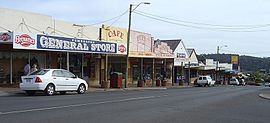Pemberton, Western Australia
|
Pemberton Western Australia |
|||||||
|---|---|---|---|---|---|---|---|

Pemberton main street.
|
|||||||
| Coordinates | 34°26′S 116°03′E / 34.44°S 116.05°ECoordinates: 34°26′S 116°03′E / 34.44°S 116.05°E | ||||||
| Population | 757 (2006 census) | ||||||
| Postcode(s) | 6260 | ||||||
| Elevation | 174 m (571 ft) | ||||||
| Location | |||||||
| LGA(s) | Shire of Manjimup | ||||||
| State electorate(s) | Blackwood-Stirling | ||||||
| Federal Division(s) | O'Connor | ||||||
|
|||||||
Pemberton is a town in the South West region of Western Australia, named after original settler Pemberton Walcott.
The region was originally occupied by the Bibbulmun Australian Aborigines who knew the area as Wandergarup, which in their language meant ‘plenty of water’.
Following an expedition to the area in 1861 by Edward Reveley Brockman, his brother-in-law Gerald de Courcy Lefroy and his uncle Pemberton Walcott, in 1862 Brockman established Warren House homestead and station on the Warren River; Walcott, after whom the town would be named, established Karri Dale farm on the northern outskirts of the later townsite; and Lefroy established a farm and flour mill on Lefroy Brook (the current site of the 100 Year Forest). Walcott remained until at least 1867. By 1868 he was at Dwalganup Station near Boyup Brook, and in 1872 Karri Dale was for sale, marketed as a "four-roomed brick cottage, stockyards, cattle shed, good garden - stocked with fruit trees and permanent running water".
In 1913, the new government-owned State Saw Mills began construction of twin sawmills, No 2 and No 3, at the location then known as Big Brook, to supply half a million railway sleepers for the Trans-Australian Railway. The mill site was in a valley to ensure the mills had a regular supply of water and because it was easier to roll logs down hill to the mills. Big Brook became a thriving private mill town, with a hall, store, staff accommodation, mill workers’ cottages, and single men’s huts, and two boarding houses. A more distinctive name was soon sought. The name Walcott was suggested but was rejected by the Post Office due to conflict with Port Walcott, also named after Walcott. William Locke Brockman, local farmer and son of early settler Edward Reveley Brockman, suggested Pemberton. The mill town was well established but by 1921 there was community agitation for a government townsite to be declared. Community pressure resulted in lots being surveyed in 1925 and the Pemberton townsite was gazetted in October 1925.
During the 1920s the area was a focus of the Group Settlement Scheme and following the Second World War the War Service Land Settlement Scheme, but with only moderate success.
...
Wikipedia

